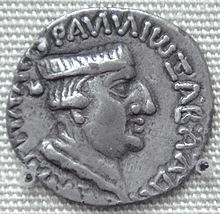Nahapana
| Nahapana | |
|---|---|
| Western Satrap | |

Silver coin of Nahapana, with ruler profile and pseudo-Greek legend "PANNIΩ ΞAHAPATAC NAHAΠANAC", transliteration of the Prakrit "Raño Kshaharatasa Nahapanasa" (or "King Kshaharata Nahapana"). British Museum.
|
|
| Reign | 1st or 2nd century CE |
| Predecessor | Bhumaka |
Nahapana (r. 1st or 2nd century CE) was an important ruler of the Western Kshatrapas, descendant of the Indo-Scythians, in northwestern India. According to one of his coins, he was the son of Bhumaka.
The exact period of Nahapana is not certain. A group of his inscriptions are dated to the years 41-46 of an unspecified era. Assuming that this era is the Shaka era (which starts in 78 CE), some scholars have assigned his reign to 119-124 CE. Others believe that the years 41-46 are his regnal years, and assign his rule to a different period. For example, Krishna Chandra Sagar assigns his reign to 24-70 CE, while R.C.C. Fynes dates it to c. 66-71 CE.
The Periplus of the Erythraean Sea mentions one Nambanus as the ruler of the area around Barigaza. This person has been identified as Nahapana by modern scholars. The text describes Nambanus as follows:
He also established the Kshatrapa coinage, in a style derived from Indo-Greek coinage. The obverse of the coins consists of the profile of the ruler, within a legend in Greek. The reverse represents a thunderbolt and an arrow, within Brahmi and Kharoshthi legends.
Nahapana is mentioned as a donator in inscriptions of numerous Buddhist caves in northern India. The Nasik and Karle inscriptions refer to Nahapana's dynastic name (Kshaharata, for "Kshatrapa") but not to his ethnicity (Saka-Pahlava), which is known from other sources.
Nahapana had a son-in-law named Ushavadata (Sanskrit: Rishabhadatta), whose inscriptions were incised in the Pandu-lena caves near Nasik. Ushavadata was son of Dinika and had married Dakshamitra, daughter of Nahapana. According to the inscriptions, Ushavadata accomplished various charities and conquests on behalf of his father-in-law. He constructed rest-houses, gardens and tanks at Bharukachchha (Bharuch), Dashapura (Mandasor in Malva), Govardhana (near Nasik) and Shorparaga (Sopara in the Thana district). He also campaigned in the north under the orders of Nahapana to rescue the Uttamabhadras who had been attacked by the Malayas (Malavas). He excavated a cave (one of Pandavleni Caves) in the Trirashmi hill near Nasik and offered it to the Buddhist monks.
...
Wikipedia
